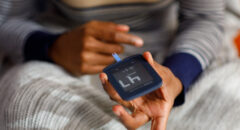
Do you know your family’s health history? Some conditions like prediabetes run in families, so it’s important to have that conversation. Learning about your family’s health can help you and them understand risks and prevent type 2 diabetes together.
So what is prediabetes?
Prediabetes develops when your blood sugar is higher than normal, but not high enough to be type 2 diabetes. Prediabetes often doesn’t have any symptoms. More than 1 in 3 American adults have prediabetes, but more than 80% of them don’t know it. That means there’s a good chance you or someone in your family is already living with prediabetes without even realizing it.
Luckily, this free 1-minute risk test is a great place to start for you and the whole family. Encourage them to find out about their risk because with early action, prediabetes can not only be prevented but it can also be reversed. Think of prediabetes as an early warning sign for type 2 diabetes.
What Does Family Health History Have to Do With Prediabetes?
Many prediabetes risk factors run in families, like obesity, high blood sugar levels, hypertension (high blood pressure), and high cholesterol. You don’t have to get too personal, but asking your family members about their health is important for you, and it shows them that you care! Here are five questions that can help you get the conversation started:
- Do people in our family have a history of having excess weight or obesity?
- Does anyone in our family have diabetes?
- Has anyone in our family been diagnosed with high blood pressure?
- Who struggles with high cholesterol?
- Has anyone ever passed away due to one of these issues?
If you do find that these conditions run in your family, you don’t have to panic. Try brainstorming together about ways you can support healthy goals and lifestyle changes together. Find out what your family might already be doing to manage their risk.
RELATED: 3 Things You Can Do to Prevent Prediabetes Today
How can you prevent or reverse prediabetes?
Some prediabetes risk factors like age, sex, and family history can’t be helped. Other risk factors having to do with lifestyle and habits can be changed when you and your family take action:
- Manage your weight: Carrying extra weight is an important risk factor for prediabetes. Choosing healthy foods and managing portion sizes, along with regular physical activity, can help you reach or stay at a healthy weight.
- Add physical activity: The less you move, the greater your risk of prediabetes. Try increasing your activity to 30 minutes a day. Remember that every bit of movement helps, even small changes like learning a new dance online, going on a walk, or taking the stairs more often can help.
- Choose nutritious foods: Some foods increase your risk of prediabetes and should be enjoyed in moderation. Limit sugary foods and drinks, simple carbohydrates like white bread, white pasta, or white rice, and processed meat like deli meat, sausage or bacon. Instead, choose vegetables, fruits, lean meats and whole grains.
- Avoid tobacco products: Smoking increases the risk of prediabetes, and diabetes. If you do smoke or use tobacco products, quitting now is one of the best things you can do for your health.
Sometimes life gets in the way and we forget to manage these things as well as we should. Lean on your family for support if you need it and help them with their health goals in return. Remember that it’s never too late to start reducing your risk with healthy changes.
Make it a family affair!
Every family has their own unique traditions, but that doesn’t mean you can’t put a healthier spin on things. While the traditional mac and cheese and smokey ham hock greens recipes will never be forgotten, a delicious lighter alternative like vegetarian collard greens or mac and cheese with whole wheat pasta could become new family favorites. Try adding activities to family functions like hula hoops, kickball, or dancing! Any activity that keeps you moving is a great choice. Lastly, keep talking about your family’s health history. It could help you prevent future health risks for you, your family, and future generations.








